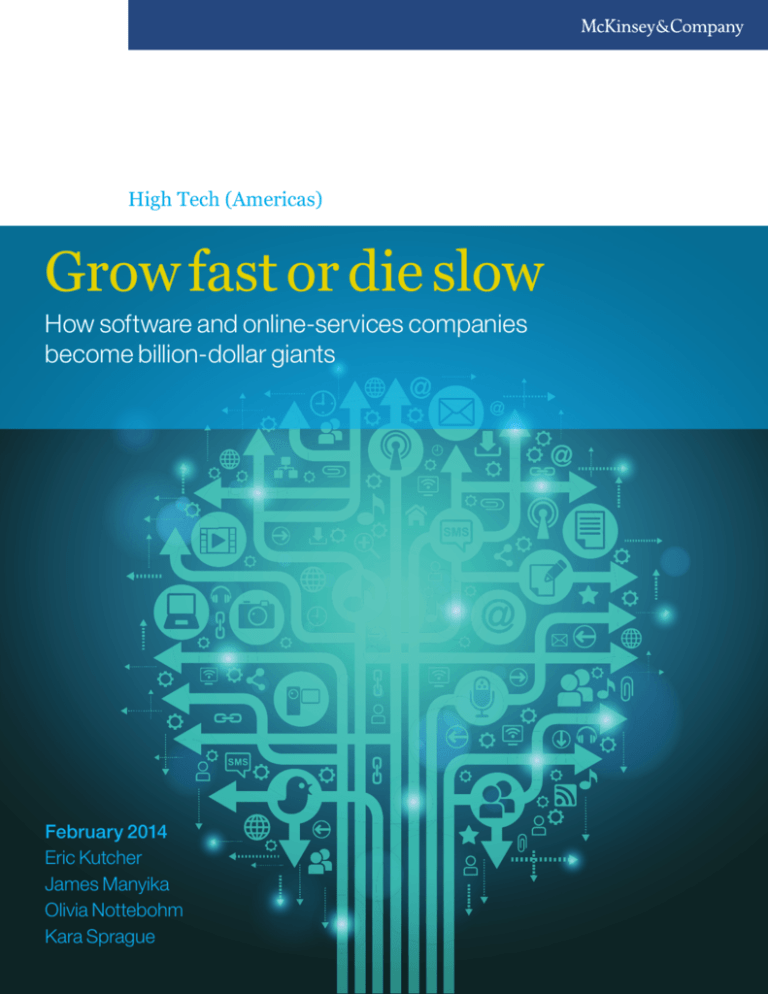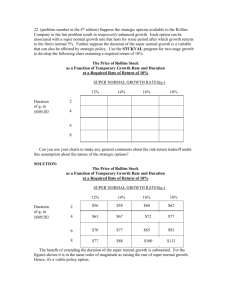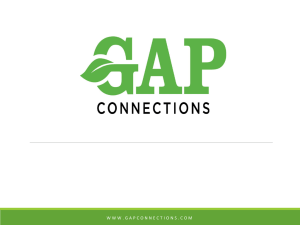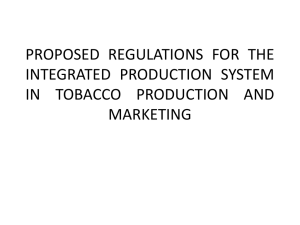Grow fast or die slow
advertisement

High Tech (Americas) Grow fast or die slow How software and online-services companies become billion-dollar giants February 2014 Eric Kutcher James Manyika Olivia Nottebohm Kara Sprague Contents Grow fast or die slow: How software and online-services companies become billion-dollar giants Growth trumps all 1 Growth yields greater returns 2 Growth predicts long-term success 2 Growth matters more than margin or cost structure 4 Sustaining growth is really hard 5 Small probability of making it big 5 Success is fleeting 5 A recipe for sustained growth 6 Growth happens in phases 6 Five critical enablers of growth in act one 7 The drivers of growth for act two are different 8 Successful companies master the transition from one act to the next 8 1 Grow fast or die slow: How software and online-services companies become billion-dollar giants Software and online services are in a period of dizzying growth. Year-old companies are turning down billion-dollar buyouts in the hopes of multibillions in a few months. But we have seen similar industry phases before, and they have often ended with growth and valuations fizzling out. The industry’s booms and busts make growth, an essential ingredient in value creation, difficult to understand. To date, little empirical work has been done to understand how important revenue growth is to software and Internet-services company success or how to find new sources of growth when old ones run out. In our new research, we analyzed the life cycles of about 3,000 software and online-services companies from around the globe between 1980 and 2012. We also surveyed executives representing more than 70 companies and developed detailed case studies of companies that grew quickly and others whose growth stalled. The research produced three main findings. Growth trumps all. Three pieces of evidence attest to the paramount important of growth. First, growth yields greater returns. High-growth companies offer a return to shareholders five times greater than medium-growth companies. Second, growth predicts long-term success. “Super growers”— companies whose growth was greater than 60 percent when they reached $100 million in revenues—were eight times more likely to reach $1 billion in revenues than those growing less than 20 percent. Additionally, growth matters more than margin or cost structure. Increases in revenue growth rates drive twice as much market-capitalization gain as margin improvements for companies with less than $4 billion in revenues. Further, we observed no correlation between cost structure and growth rates. Sustaining growth is really hard. Two facts emerged from the research. Companies have only a small probability of making it big. Just 28 percent of the software and Internet-services companies in our database reached $100 million in revenue, and 3 percent reached $1 billion. Of the approximately 3,000 companies we analyzed, only 17 achieved $4 billion in revenue as independent companies. Moreover, success is fleeting. Approximately 85 percent of super growers were unable to maintain their growth rates, and once lost, less than a quarter were able to recapture them. Those companies that did regain 1 their historical growth rate had market capitalizations 53 percent lower than those that maintained super growth throughout. There is a recipe for sustained growth. While every company’s circumstances are unique, the research found four principles that are essential to sustaining growth and from which every company can benefit. First, growth happens in phases: from start-up to billion-dollar giant, growth stories typically unfold as a prelude, act one, and act two. In act one, there are five critical enablers of growth: market, monetization model, rapid adoption, stealth, and incentives. A third principle is that the drivers for growth in act two are different. Successful strategies in act two include expanding the act-one offer to new geographies or channels, extending the act-one success to a new product market, or transforming the act-one offer into a platform. Finally, successful companies master the transition from one act to the next. Pitfalls include transitioning at the wrong time and selecting the wrong strategy for the next act. Company leaders can use these insights to understand their growth trajectory and determine whether their current products and strategy are sufficient to reach their aspiration. If not, the research can help them determine the right time to make the transition to a second act that can sustain their growth and avoid some common pitfalls that have derailed several such transitions. Growth trumps all It’s no secret that growth matters for any company and that software and online-services companies1 grow faster than those in other sectors. Classical corporate-finance theory holds that value creation stems from only two sources, growth and return on invested capital. In software and services, one of these matters more than the other. While returns on capital are often strong in mature companies, it is growth that matters most in the early stages of a company’s life. But few executives can say precisely how important growth is to these companies, or how it is achieved. The rules of the road in other industries do not apply here. If a healthcare company grew at 20 percent annually, its managers and investors would be happy. If a software company grows at that rate, it has a 92 percent chance Our data set is drawn from the McKinsey Corporate Performance Center and includes around 3,000 companies active between 1980 and 2012 in the Internet, application, gaming, and systems sectors; it excludes network providers and hardware/device companies. 2 of ceasing to exist within a few years. Even if a software company is growing at 60 percent annually, its chances of becoming a multi-billion dollar giant are no better than a coin flip. In this section, we will explore the unique physics of growth in these industries - the principles that underlie revenue expansion in software and online services. We created two samples of companies: those with between $100 million and $200 million in annual sales, and those with between $1 billion and $1.5 billion. We then divided these into three rates of annual growth: super growers (greater than 60 percent two-year compound annual growth rate (CAGR) at the time they reach $100 million in sales and greater than 40 percent at $1 billion), growers (CAGR between 20 and 60 percent at $100 million and between 10 and 40 percent at $1 billion), and stallers (CAGR of less than 20 percent at the first threshold and less than 10 percent at the second). Note that these stallers underperformed only in the context of their sector; on average, they achieved growth rates that would be the envy of companies in most industries. We found that only a small fraction were super growers: 10 percent and 15 percent, respectively (Exhibit 1). That’s a big drop-off from the period before they reached $100 million in sales, when 50 percent of our sample grew at more than 60 percent annually. Growth yields greater returns Using this same segmentation, we studied the impact of growth rates on total returns to shareholders. We found that at the first threshold, super growers generated five times more shareholder returns than growers did; at the second, they produced twice as much. The stallers, with growth rates below 20 percent, actually produced negative returns to shareholders, between –10 and –18 percent depending on company size (Exhibit 2). Growth predicts long-term success Perhaps even more important, our research revealed that higher growth rates portend sustained success. In fact, super growers were eight times more likely than stallers to grow from $100 million to $1 billion and three times more likely to do so than growers (Exhibit 3). Exhibit 1 Only a small fraction of companies achieve the highest rates of growth. Companies at $100 million–$200 million in revenue1 100% = 612 companies2 Super grower (>60% CAGR3) Companies at $1 billion–$1.5 billion in revenue1 100% = 73 companies Super grower (>40% CAGR) Staller (<20% CAGR) Grower (20–60% CAGR) 10 Citrix eBay Oracle Yahoo Salesforce.com 15 eBay Facebook Google Microsoft 30 Adobe Autodesk BMC Software Digital River Microsoft Monster Novell Symantec 40 Adobe Autodesk CA Technologies Citrix Oracle Yahoo 45 BMC Software Computervision Monster Synopsys 60 24/7 Real Media Alpha Systems CDC Corporation Phoenix Technologies Staller (<10% CAGR) Grower (10–40% CAGR) 1 Segment boundaries are determined by 3 criteria: significant differences in average market-capitalization performance of each group after hitting revenue marker of $100 million or $1 billion, significant differences in each group’s average performance on total returns to shareholders, and sufficient size for comparative analysis. 2 Excludes companies that have no data for compound annual growth rate, were acquired within 2 years of reaching the revenue threshold, or went bankrupt. 3 Compound annual growth rate. High Tech (Americas) Grow fast or die slow: How software and online-services companies become billion-dollar giants 3 Exhibit 2 Super growers create five times more shareholder value than slower growers. Total returns to shareholders, 3 years after reaching threshold % $100 million–$200 million in revenue Super grower 20 4 Grower Staller $1 billion–$1.5 billion in revenue 16 7 5x –10 –18 n = 4671 n = 651 1 Excludes companies that have no data for compound annual growth rate, were acquired within 2 years of reaching the revenue threshold, or went bankrupt. Exhibit 3 Super growers are eight times more likely than stallers to reach $1 billion in revenues. Companies at $100 million– $200 million in revenue1 100% = 612 companies2 Super grower (>60% CAGR3) % that go on to reach $1 billion in revenue1 Grower (20–-60% CAGR) Staller (<20% CAGR) 10 30 52 60 ~8x 17 6 1 Segment boundaries are determined by 3 criteria: significant differences in average market-capitalization performance of each group after hitting revenue marker of $100 million or $1 billion, significant differences in each group’s average performance on total returns to shareholders, and sufficient size for comparative analysis. 2 Excludes companies that have no data for compound annual growth rate, were acquired within 2 years of reaching the revenue threshold, or went bankrupt. 3 Compound annual growth rate. 4 Growth matters more than margin or cost structure So, growth is essential to value creation. But is it more important than other factors, such as cost control and operating excellence? We analyzed the relationship of cost structure to growth and found little or no correlation. In every major cost category—cost of goods sold, R&D, marketing and sales, and overhead—there is little or no correlation between the level of expense or investment and growth rate (Exhibit 4). Fast-growing companies can spend a lot or a little on these categories; it doesn’t seem to matter. As expected, in the software and online-services industries, with their outsize returns on capital, we found that changes in top-line growth deliver twice the valuation gain that margin improvements make. Exhibit 5 lays out the two routes of improvement for a software or online-services company. Companies with earnings before interest, taxes, and amortization (EBITA) margins below 10 percent and growth rates below 20 percent (bottom-left quadrant) have seen their market capitalization grow 14 percentage points more slowly than the market average. The data suggest that they can drive nearly twice as much value by pushing growth rates over 20 percent as they can by pushing EBITA margins above 10 percent. Companies with EBITA already in excess of 10 percent but top-line growth below 20 percent achieve a similar market-capitalization improvement by boosting their top-line growth above 20 percent. There is, however, one notable exception to the idea that growth is all-important. When companies reach $4 billion in revenues or more, margins become more important to value multiples. Exhibit 4 Costs and growth have little or no correlation. 2012 revenue (bubble size indicates revenue) >$9 billion Total cost % of revenue $4 billion–$9 billion $1 billion–$4 billion Total cost % of revenue 100 COGS1 150 50 0 60 100 R&D 40 20 0 60 50 M&S2 0 –50 0 50 100 150 20 0 20 200 Year-on-year growth % 40 15 G&A3 10 5 0 1 Cost of goods sold. 2 Marketing and sales. 3 General and administrative. Source: S&P Capital IQ; McKinsey analysis –50 0 50 100 150 200 Year-on-year growth % High Tech (Americas) Grow fast or die slow: How software and online-services companies become billion-dollar giants 5 Exhibit 5 Growing faster has twice as much impact on share price as improving margins. Changes in market-capitalization growth rate,1 1980–2012 % X% Market-capitalization CAGR over industry average ~23 point increase by increasing revenue growth 10% 23% –14% 0% ~14 point increase by improving margin Revenue CAGR2 ≥20% <20% <10% ≥10% EBITA margin3 1 Change is calculated in comparison with industry average. Companies studied had less than $4 billion in revenue. 2 Compound annual growth rate. 3 EBITA = earnings before interest, taxes, and amortization; 2-year average. Sustaining growth is really hard As would be expected, if growth is especially important to achieve in software and online services, then sustaining it is especially difficult. Our research produced two critical findings about the difficulty of sustaining growth. Exhibit 6 Few companies reach $4 billion in revenue. PUBLIC-COMPANY DATA Number of companies that reached revenue thresholds, 1980–20121 2,952 By 2012, 17 surpassed $4 billion: Small probability of making it big In an industry that sees an extraordinary number of startups, very few go on to become giants. Of the nearly 3,000 companies that we studied, only 28 percent reached $100 million in annual revenues; 3 percent went on to log $1 billion in annual sales, and just 0.6 percent—17 companies in total— grew beyond $4 billion (Exhibit 6). 826 Activision Blizzard Adobe Amazon CA Technologies eBay Electronic Arts Facebook Google Intuit Microsoft Nintendo Oracle SAP Symantec Tencent VMware Yahoo 96 Success is fleeting As mentioned, high rates of growth are a predictor of longterm success. We analyzed the 96 companies that reached $1 billion in annual sales and found that fully 85 percent were in the top two categories of growth (super growers and growers) when the companies were smaller. Forty- $100 million $1 billion 17 $4 billion 1 Companies that are currently public and are in the following categories: Internet, application, gaming, and systems (excludes pure network providers). 6 five percent stayed in those categories—they kept their growth rate consistent—and when they reached $1 billion in sales, the prize for this growth was not only survival, but thriving performance, as evidenced by a much higher market capitalization/revenue multiple than the companies that took a slower route to $1 billion in revenue. Most interesting to us, companies whose growth rate fell off and then recovered created less than a quarter of the value of the companies that maintained growth—despite similar rates of growth at the $1 billion threshold (Exhibit 7). Taking their foot off the pedal for even a short stint had dramatic longterm consequences. Bankers call this the “humpty dumpty” problem: once growth is broken, it is impossible to put back together again. That pattern of slowdown and recovery is unusual and attests to the importance of consistent growth. Many companies experience a slowdown in growth (Exhibit 8): 217 of the companies in the top two categories slipped one notch within three years after reaching $100 million in revenue. Only about one-third were able to climb back to the fastest rates of growth. A recipe for sustained growth Given the importance of growth and the very real difficulty of sustaining the highest rates of growth, we wondered if there were any common practices or standards applied by successful growers. Through case-study research and interviews and surveys of senior executives in more than 70 software and online-services companies, we uncovered four principles for sustaining growth. While every company’s situation is unique, these principles seem to be universal. Following them will not guarantee growth but will certainly give a company a better chance at finding and sustaining growth. Growth happens in phases Our first conclusion is the importance of approaching growth as an episodic phenomenon. We found three critical phases, which we call the prelude, act one, and act two. In the prelude, companies test the fit between product and market, typically through bespoke or one-off solutions for initial customers. The prelude is all about finding an offer and business model that appeal to a broad customer set. This is a vital phase, of course, but has been well studied. Exhibit 7 Consistently high growth produces the most valuable companies. Growth segment when $100 million–$150 million in revenues 85% super grower or grower Growth segment when $1 billion–$1.5 billion in revenues Average market capitalization/revenue multiple 3 years after reaching $1 billion 45% remained super grower or grower 6.5 40% became staller 96 companies that reached $1 billion in revenue 3.5 10% became super grower or grower 1.5 5% remained staller 1.5 15% staller Even companies that reignite their growth engine suffer from lower multiples High Tech (Americas) Grow fast or die slow: How software and online-services companies become billion-dollar giants 7 Exhibit 8 Companies that slow down find it hard to recover. Recovery rates of companies that fell 1 growth category, 1980–2012 Number of companies 2 years after achieving $100 million 65 Any time after 3 years1 of achieving $100 million Any time after experiencing growth downgrade 53 12 –82% 41 Super grower 193 Grower 12 Became grower or staller 164 Became staller 22% Returned to super grower –85% 56 34% Returned to super grower or grower 1 Analysis based on the 3-year trailing growth rate of 612 companies after they reach $100 million in revenue. We are more interested in the two phases that follow. In act one, companies narrow their focus to an offer that truly scales, both with regard to serving many customers and consistently delivering revenues. It is with this first scaling offer that software and Internet-services companies prove their first business model and typically ride to tens or hundreds of millions (or even, on rare occasions, billions) of dollars in revenues. Importantly, at this point most companies that experience this kind of super-grower success turn to the public markets for growth capital through an IPO. A capital infusion may help sustain growth for a time as a company expands its act-one offer to new customer segments or geographies. But in most cases the adoption curve will reach its natural conclusion, and act one will no longer offer a sufficient growth engine. For companies to sustain growth, they must typically identify their second act—a second offer that scales. Five critical enablers of growth in act one For act one, we identified five critical steps to drive growth, some well understood and others less obvious. The first is to pick the right market, ideally a “limitless” market with millions of end points (that is, users or devices). Google’s addressable market, for example, is every Internet user on the planet— some 2.4 billion people—and the approximately $500 billion (and growing) worldwide spending on advertising. Similarly, LinkedIn addresses a market that includes any professional and anyone looking to hire a professional. Next is to define a monetization model that enables the company to capture demand without stifling it and thus to scale up successfully. Figuring out the best way to capture the value created by a company’s offering is critical since it essentially defines a company’s business model and is difficult to change later. For example, one popular software company tied monetization of its act-one product to a physical construct, processors. The company later tried to introduce a different pricing model that was more directly tied to the usage of the product. Even though the model change benefited a large majority of customers, the customers who it didn’t benefit were so vocal that the company had to revert to the original model. 8 Third is to focus on rapid adoption. This approach protects a company from becoming caught up in the demands of serving a particular customer set. Our interviews and case studies revealed numerous instances of companies becoming lost in the pursuit of the “lighthouse” customer. These companies made major concessions across product and pricing to win over a large account. Though in some instances this resulted in a major reference customer, it hindered the development of a product designed for mass use, or of a streamlined operational capability (for example, “zero-cost provisioning”). The fourth factor is stealth. Andrew Grove, former CEO of Intel, famously spoke of paranoia as a virtue. Given the pace at which the barriers to entry are falling in this industry, maintaining a low profile while alpha and beta products are developed is vital. In several of our interviews, CEOs discussed the weak intellectual-property protection provided by patents as a prime example of these low barriers. The fifth and final enabling action is to create proper incentives for the leadership team to remain committed to the company, through act one and beyond. Both in their culture and in their incentive structure (for example, change of control agreements), many start-ups give little thought to life beyond the IPO. Instead, companies and their executives should be focused on building $1 billion companies—with respect to revenue and not market capitalization. The drivers of growth for act two are different Act two presents new challenges. Having achieved a foothold (or more) in the marketplace, what next? How can executives keep their software or online-services company growing? Our research established that, in the span between $100 million and $1 billion in annual revenues, many companies run up against either natural market-size or market-share limits to their core product or service. Those companies able to grow successfully to $1 billion and beyond used at least one of three viable growth strategies to get past these boundaries. First, a fortunate few built robust enough act-one business models that they could simply expand for their second act. These companies opened new geographies (as Facebook did, focusing on Anglophone markets), new outlets (as Google did with Gmail), or new categories (as Amazon did in expanding its e-commerce engine to new retail categories). This approach is only viable for those companies whose act one addresses a target market that is so sizable and fast growing it can support multiple phases of growth. Second, some companies extend their proven business model into adjacent markets. For example, Microsoft replicated its success in desktop operating systems when it moved into server operating systems and eventually enterprise applications (such as Dynamics and SharePoint). Many companies using this strategy made sizable acquisitions a key component of their growth story, buying footholds in adjacent markets and overcoming the difficulties of integration. Oracle built out its portfolio of enterprise applications primarily via large acquisitions (for example, BEA Systems, PeopleSoft, Siebel, and Taleo). Adobe, SAP, and Symantec also used M&A in this way, acquiring large segments in adjacent markets and excelling in postmerger integration. Third, some companies successfully grow when they transform their core product into a platform, around which an “ecosystem” of complementary products and services can arise. Microsoft successfully used this strategy when it parlayed its leadership in PC operating systems to commensurate success in PC productivity software (that is, Microsoft Office, built on top of Microsoft Windows). Salesforce.com followed a similar playbook with its Force. com platform, which encourages developers to create new tools using its application programming interfaces and provides Salesforce.com with valuable insight into future product areas. Successful companies master the transition from one act to the next Figuring out the right time to begin the transition to act two is a nontrivial management decision. Moving too soon could prevent a company from reaping all of act one’s market potential and could enable competitors to gain share. Moving too late and letting growth slow results in lower valuations, and ultimately in the loss of market relevance, as the research shows. Consequently, knowing when to transition is critical. From our work, we have seen several leading indicators of a coming stall: slowing acquisition of customers due to market saturation, declining lifetime value of new customers, decreasing High Tech (Americas) Grow fast or die slow: How software and online-services companies become billion-dollar giants participation of ecosystem partners (developers or channel resellers), and market disruption from new entrants. A final barometer of impending slowdown is the loss of key talent from sales, presales, or engineering. When the moment is right, companies should pressure-test their act-two strategy and be aware of a couple of common pitfalls. First, some companies select the wrong market or product offering for their second act. This failure can be attributed to insufficient diligence in assessing the new market or not having the right capabilities in-house to design and build that next major offering. Companies can also underinvest in the resources or budget required to make the act-two offering a success. One can find many examples among defunct software companies. Borland and VisiCorp (creators of VisiCalc) both fall into this category, as they failed to grow significantly on their own and were instead acquired for very little. 9 The growth powering a company’s first act will eventually run into natural limits. In our view, every CEO should be continually asking these five questions to evaluate when and how to maintain or accelerate their growth trajectory: How much growth do we need, and how quickly do we need it? How much growth is left in our core markets? How secure are we in our core markets? What opportunities do we have to expand our current businesses and to generate more cash to invest in growth? What new opportunities do we see that might present us with a great next act, and when do we move? The authors thank Philipp Bolt, Ted Callahan, Alex Ince-Cushman, Darren Noy, and Akiko Yamada for their substantial contributions to this paper. Eric Kutcher is a director in McKinsey’s Silicon Valley office, where Olivia Nottebohm is a principal, and James Manyika is a director in the San Francisco office, where Kara Sprague is a principal. High Tech (Americas) February 2014 Designed by Global Editorial Services Copyright © McKinsey & Company







